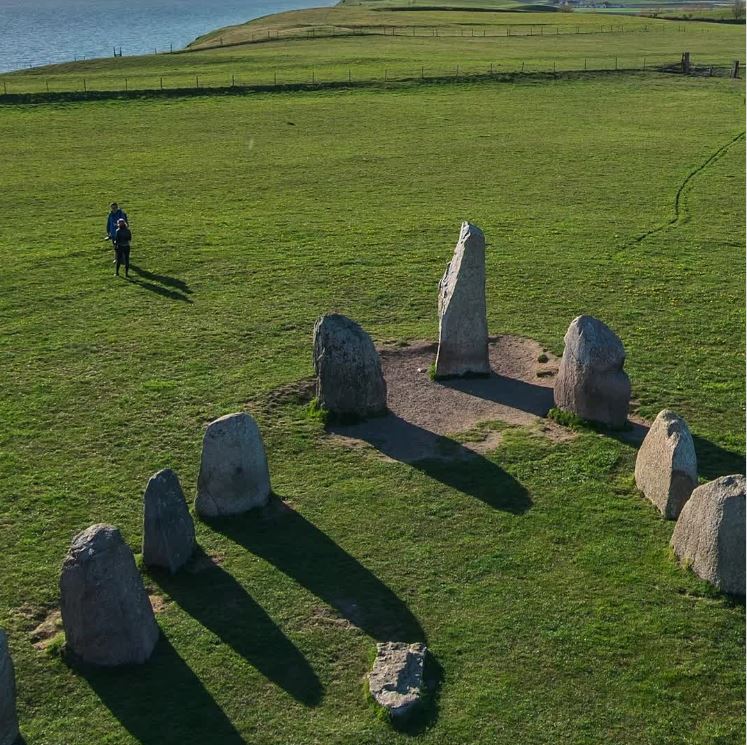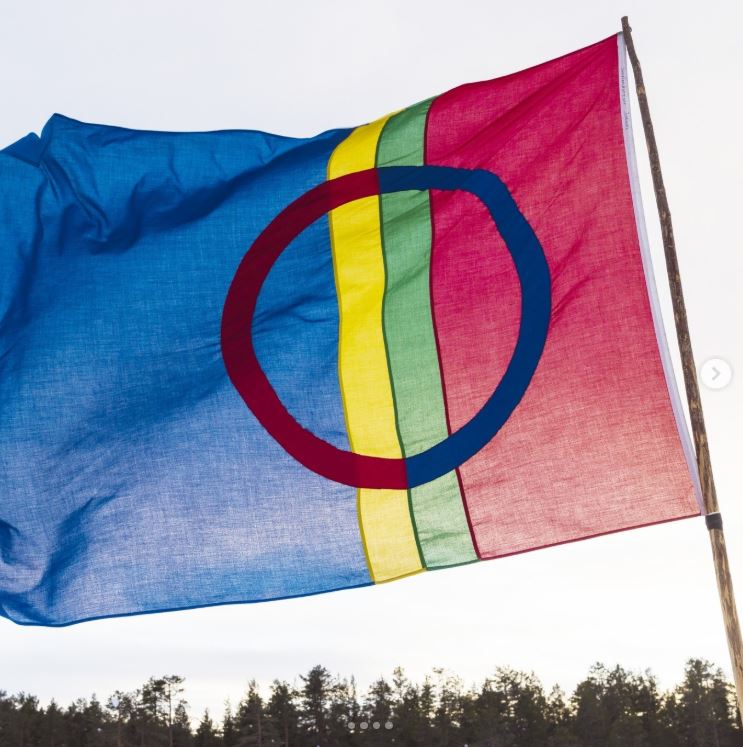History of Sweden
Ice Age, Iron Age, IT Age. This is your quick guide to the history of Sweden.
We'll start this journey through the history of Sweden in the period of 8,000 BC to 6,000 BC. This is when Sweden as a whole became populated by people who lived by hunting, gathering and fishing, and who used simple stone tools. Dwelling places and graves dating from the Stone Age, lasting until about 1,800 BC, are found today in increasing numbers.
The Bronze Age was marked in the Nordic region – especially in Denmark, but also in Sweden – by a high level of culture, shown by the artifacts found in graves.
After 500 BC, such artifacts become increasingly rare as iron came into more general use. During the early Iron Age, the population of Sweden became settled, and agriculture came to form the basis of the economy and society.
The Sami in Sweden
The Sami were only recognised by the Swedish parliament as an indigenous people in 1977. In 1993, the Sami parliament, Sametinget, was established. It is both a democratically elected body and a national administrative authority.
The Sami
The Sami are one of the indigenous peoples of the world. The first document to mention the Sami in Sweden was written almost 2,000 years ago. Inland parts of upper Norrland are known to have been inhabited even longer, however – for close to 10,000 years.
Vikings and early Christians
The Viking Age (800–1050 AD) was characterised by a significant expansion of activity, in Sweden’s case largely toward the east. Many Viking expeditions set off from Sweden to both plunder and trade along the Baltic coast and the rivers that stretched deep into present-day Russia.
The Vikings traveled as far as the Black and Caspian Seas, where they developed trading links with the Byzantine Empire and the Arab kingdoms. Christianity first reached Sweden with a mission led by Ansgar, who visited in the 9th century, but the country was not converted to Christianity until the 11th century.
There are more than 2,500 rune stones in Sweden, with messages dating from the 5th century to the mid-12th century, making them the oldest preserved Swedish documents. Relatives often had stones erected in memory of a dead family member.
Founding of the kingdom
The various provinces of Sweden were absorbed around 1000 AD into a single unit, but the crown began to gain significant influence only during the late 13th century. In 1280, King Magnus Ladulås (1275–90) issued a statute authorising the establishment of a nobility and the organisation of society on the feudal model.
The Hanseatic period
Trade grew during the 14th century, especially with the German towns grouped under the leadership of Lübeck. By the mid-16th century, this group, known as the Hanseatic League, dominated Swedish trade, and many towns were founded as a result of lively commercial activity. However, the Black Death, which reached Sweden in 1350, led to a long period of economic and population decline.
King Gustav II Adolf (1611–32)
Intervened in the Thirty Years’ War, making Sweden a leading military power. Gustav II Adolf was killed at the Battle of Lützen.
Queen Kristina (1632–54)
The first female monarch after Sweden became a hereditary monarchy. Abdicated in 1654, converting to Catholicism and settling in Rome.
King Gustav III (1771–92)
Called the Theatre King, Gustav III founded Stockholm's first opera, the Swedish Academy and the Royal Academy of Music. Assasinated at a masquerade ball.
The Kalmar Union
In 1389, the crowns of Denmark, Norway and Sweden were united under the rule of the Danish Queen Margareta. In 1397, the Kalmar Union was formed, with the three Scandinavian countries under a single monarch.
However, the union (1397–1523) was scarred by internal conflicts that culminated in the ‘Stockholm Bloodbath’ in 1520, when 80 Swedish nobles were executed at the instigation of the Danish union king, Kristian II. The act provoked a rebellion, which in 1521 led to the deposition of Kristian II and the seizure of power by a Swedish nobleman, Gustav Vasa, who was elected king of Sweden in 1523.
The Vasa period
The foundations of the Swedish state were laid during the reign of Gustav Vasa (1523–60). The church was nationalised, its estates confiscated by the crown, and the Protestant Reformation was introduced. Power was concentrated in the hands of the king and hereditary monarchy came into force in 1544.
The Swedish empire
Following the dissolution of the Kalmar Union, the Swedish foreign policy was aimed at gaining control over the Baltic Sea, which led to repeated wars with Denmark from the 1560s onward.
After Sweden intervened in 1630 with great success in the Thirty Years’ War on the side of the German Protestants, and Gustav II Adolf became one of Europe’s most powerful monarchs, Sweden defeated Denmark in the two wars of 1643–45 and 1657–58. Finland, provinces in northern Germany and the present-day Baltic republics also belonged to Sweden, and after the Peace of Westphalia in 1648 and the Peace of Roskilde with Denmark in 1658, Sweden was a great power in northern Europe. The country even founded a short-lived colony in what is now Delaware in North America.
Lacking resources
With a largely agrarian economy, Sweden lacked the resources to maintain its position as a great power in the long run. After its defeat in the Great Northern War (1700–21) against the combined forces of Denmark, Poland and Russia, Sweden lost most of its provinces on the other side of the Baltic Sea and was reduced essentially to the same frontiers as present-day Sweden and Finland.
During the Napoleonic Wars, Sweden surrendered Finland to Russia. As compensation, the French marshal Jean Baptiste Bernadotte, who had been elected heir to the Swedish throne in 1810, succeeded in obtaining Norway, which was forced into a union with Sweden in 1814. This union was peacefully dissolved in 1905 after many internal disputes.
18th/19th century Sweden
After the death of the warrior king Karl XII in 1718 and Sweden’s defeat in the Great Northern War, the Swedish parliament and council were strong enough to introduce a new constitution that abolished royal absolutism and put power in the hands of parliament.
Eighteenth-century Sweden was characterised by rapid cultural development, partly through close contact with France. Overseas trade was hard hit by the Napoleonic Wars, which led to general stagnation and economic crisis in Sweden during the early 19th century. In the late 19th century, 90 per cent of the people still earned their livelihoods from agriculture.
One consequence was emigration, mainly to North America. From the mid-19th century to 1930, about 1.5 million Swedes emigrated, out of a population of 3.5 million in 1850 and slightly more than 6 million in 1930.
Industry did not begin to grow until the 1890s, although it then developed rapidly between 1900 and 1930 and transformed Sweden into one of Europe’s leading industrial nations after World War II.
Saint Bridget (1303–1373)
Bridget (Birgitta in Swedish) was known for her ‘heavenly revelations’, visions and prophetic messages, which she relayed to popes and princes. In 1491, she was canonised. In 2000, she was proclaimed a patron saint of Europe.
Alfred Nobel (1833–1896)
When inventor Alfred Nobel died, he had a total of 355 patents. The Nobel Prizes were a bequest from Nobel for achievements in physics, chemistry, physiology or medicine, literature and peace.
Dag Hammarskjöld (1905–1961)
Dag Hammarskjöld was appointed UN secretary-general in 1953. He was known for his ‘quiet diplomacy’. In 1961, he tragically died in a plane crash. Shortly after, he was posthumously awarded the Nobel Peace Prize.
The 20th century – a century of reforms
Late 19th-century Sweden was marked by the emergence of strong popular movements that included the free churches, the temperance and women’s movements, and above all the labour movement.
The labour movement, whose growth kept pace with industrialisation in the late 19th century, was reformist in outlook after the turn of the 20th century.
The first Social Democrats entered government in 1917. Universal suffrage was introduced for men in 1909 and for women in 1921. Plans for a welfare state were drawn up during the 1930s after the Social Democrats rose to power, and put into effect after World War II.
The postwar era
During World War II, a coalition of Sweden’s four ‘democratic’ parties (excluding the Communists) formed the government. After the war ended, a purely Social Democratic government resumed office under Per Albin Hansson. Under Social Democratic leadership, but in close co-operation with the other democratic parties, a series of reforms were carried out in the 1940s and 1950s that together laid the foundations of the Swedish welfare state. At the same time, there were calls for a modernization of the 1809 constitution.
A new Instrument of Government was adopted in 1974, stating that all public power is derived from the people, who are to select the members of parliament in free elections. The monarch is still the head of state, but in name only. In 1979, an amendment to the order of succession gave male and female heirs an equal claim to the throne. Accordingly, Crown Princess Victoria is next in line to the throne, not her younger brother, Carl Philip.
Foreign policy
Since a short war against Norway in 1814 in conjunction with the creation of the union, Sweden has not been involved in any war. Since World War I, Sweden has pursued a policy of non-alignment in peacetime and neutrality in wartime, basing its security on a strong national defense.
Nonetheless, Sweden joined the League of Nations in 1920 and the United Nations in 1946. The first UN operation involving Swedish troops took place in Suez in 1956. Since 1994, Sweden has also co-operated with NATO under the Partnership for Peace. Through these organisations, Sweden has been involved in numerous international peacekeeping missions.
In 2024, Sweden formally joined NATO.
Sweden and the EU
Sweden joined the EU on 1 January 1995. In a national referendum in 2003, a majority of the country’s voters voted not to join the euro.
With the Presidency of the Council of the European Union rotating among the EU member states every six months, Sweden has held the Presidency on three occasions to date: during the first half of 2001, the second half of 2009 and the first half of 2023.
Swedish governments
- 1976: Non-socialist coalition government under the leadership of Centre Party chairman Thorbjörn Fälldin, marking the end of four decades of uninterrupted Social Democratic rule.
- 1982: Social Democratic Party, with Olof Palme as prime minister.
- The murder of Olof Palme on 28 February 1986, came as a shock to the Swedish people, who had been spared such political violence for almost 200 years. Palme’s successor as prime minister was Ingvar Carlsson.
- 1991: Non-socialist coalition government, with Moderate Party leader Carl Bildt as prime minister.
- 1994: A minority government led by Social Democrat Ingvar Carlsson. In 1996, Carlsson stepped down and was replaced by his finance minister, Göran Persson, who remained prime minister for 10 years.
- 2006: The Moderate Party emerged as the main victor. Together with the Centre Party, the Liberal Party and the Christian Democrats, it formed a coalition government headed by Prime Minister Fredrik Reinfeldt.
- 2010: Although the Moderate Party achieved its best election result yet, Reinfeldt had to retain his coalition partners to stay in office. For the first time in history, there were eight parties in the Riksdag, including an far-right party for the first time.
- 2014 The Social Democrats and the Greens won the election and formed a minority coalition, led by Stefan Löfven.
- 2018 After a lengthy process (only ending in January 2019), the Social Democrats and Greens formed a minority government with support from the Liberal and Centre parties. Prime minister: Stefan Löfven.
- 2021 After the resignation of Stefan Löfven, Magdalena Andersson became Sweden's first female prime minister.
- 2022 The Moderate Party, the Christian Democrats and the Liberal Party form a government. Moderate Party leader Ulf Kristersson becomes prime minister.



